Report on Diversity, Recruitment, and Selection Strategies for CERA
VerifiedAdded on 2020/04/07
|15
|3693
|68
Report
AI Summary
This report examines the importance of diversity, recruitment, and selection within CERA, an Australian civil construction organization. It highlights the benefits of a diverse workforce, including enhanced creativity, flexibility, and competitive advantage, while also acknowledging potential challenges like communication issues. The report analyzes the business case for diversity, emphasizing the value of different perspectives and cultural backgrounds in driving innovation and meeting client needs. It proposes various strategies for CERA to achieve and manage diversity effectively, such as implementing inclusive recruitment policies, providing employee training, fostering workplace flexibility, and promoting transparent hiring processes. The report underscores the need for strategic thinking and people-centered policies to leverage the strengths of a diverse workforce and create a more inclusive and successful organization. The report also suggests strategies for job attraction to ensure that applicants come from diverse backgrounds.
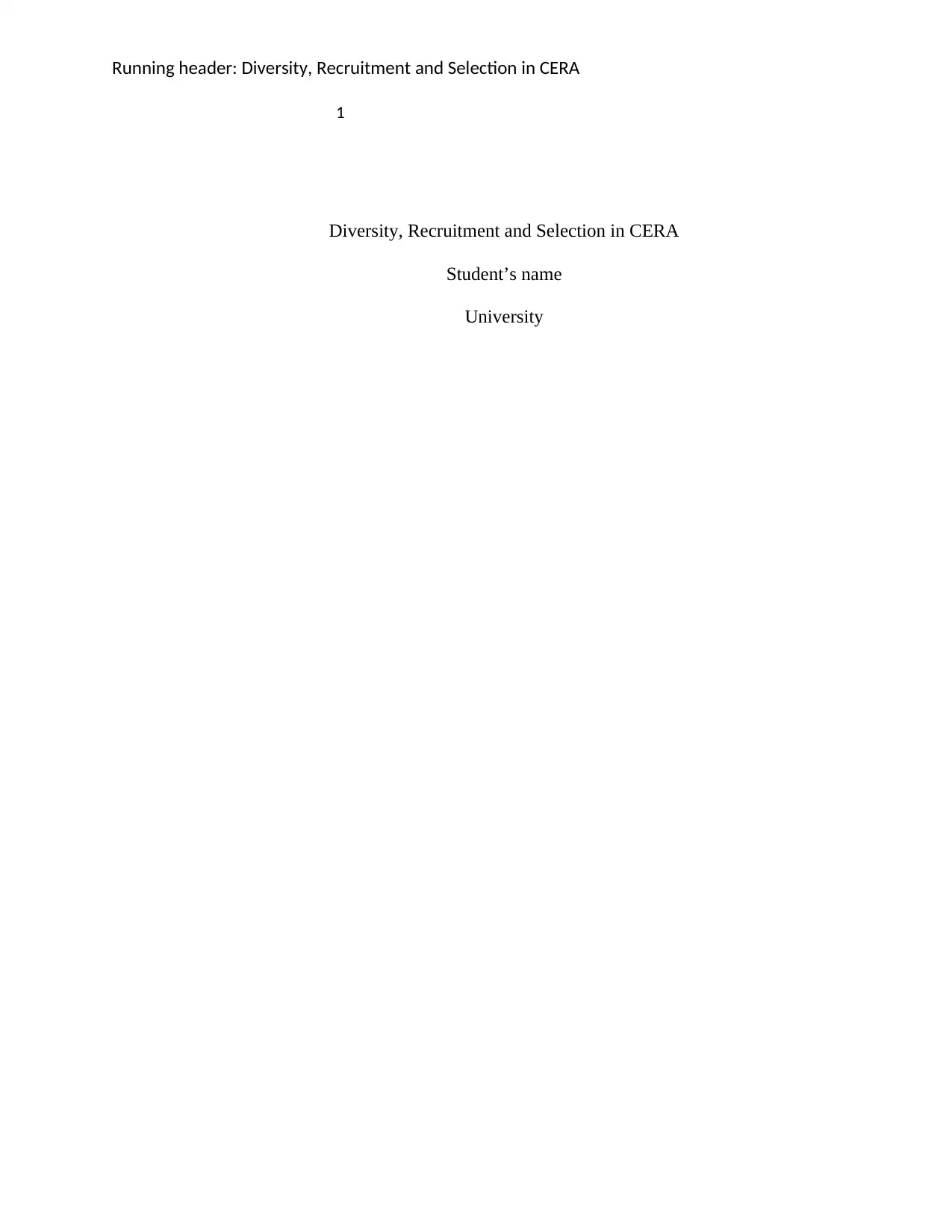
Running header: Diversity, Recruitment and Selection in CERA
1
Diversity, Recruitment and Selection in CERA
Student’s name
University
1
Diversity, Recruitment and Selection in CERA
Student’s name
University
Paraphrase This Document
Need a fresh take? Get an instant paraphrase of this document with our AI Paraphraser
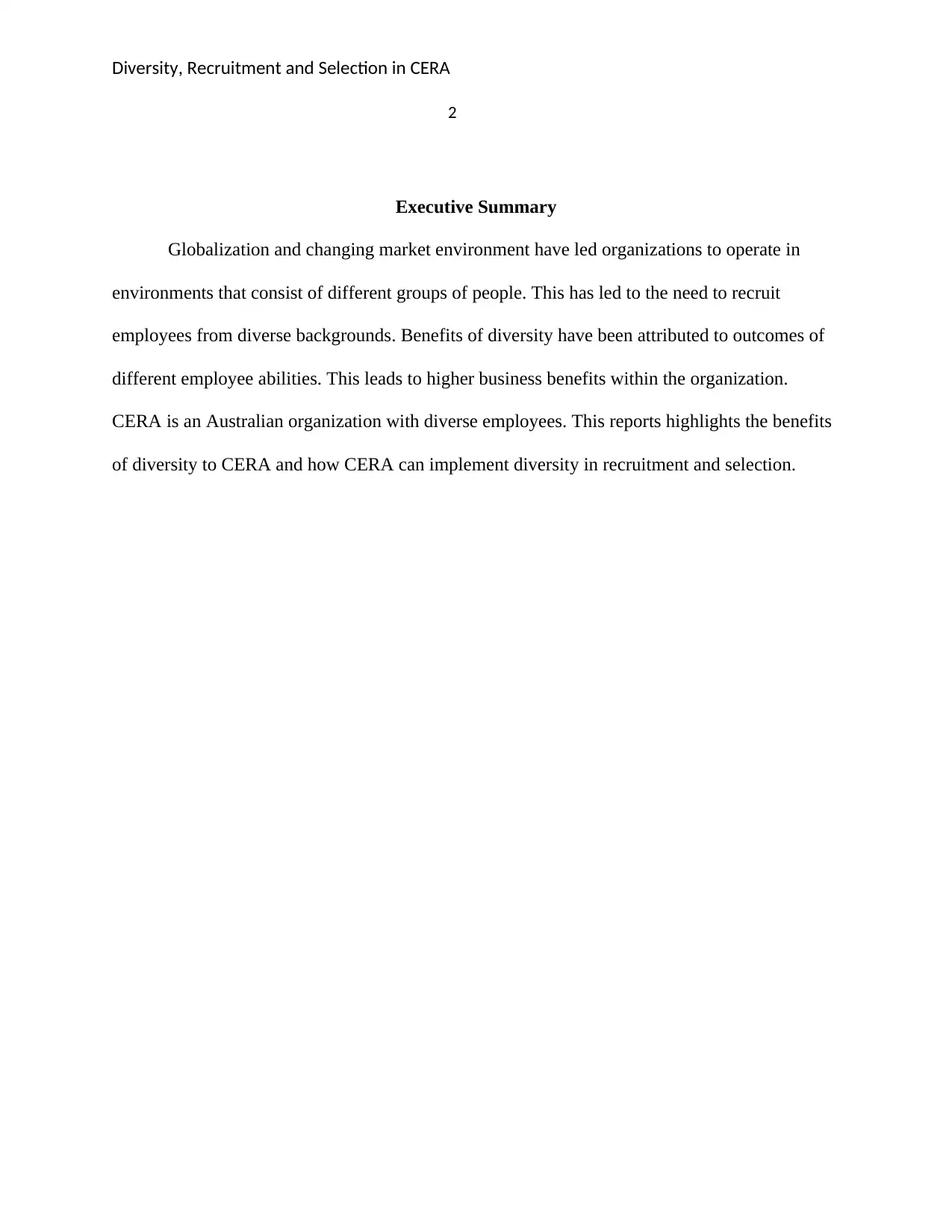
Diversity, Recruitment and Selection in CERA
2
Executive Summary
Globalization and changing market environment have led organizations to operate in
environments that consist of different groups of people. This has led to the need to recruit
employees from diverse backgrounds. Benefits of diversity have been attributed to outcomes of
different employee abilities. This leads to higher business benefits within the organization.
CERA is an Australian organization with diverse employees. This reports highlights the benefits
of diversity to CERA and how CERA can implement diversity in recruitment and selection.
2
Executive Summary
Globalization and changing market environment have led organizations to operate in
environments that consist of different groups of people. This has led to the need to recruit
employees from diverse backgrounds. Benefits of diversity have been attributed to outcomes of
different employee abilities. This leads to higher business benefits within the organization.
CERA is an Australian organization with diverse employees. This reports highlights the benefits
of diversity to CERA and how CERA can implement diversity in recruitment and selection.
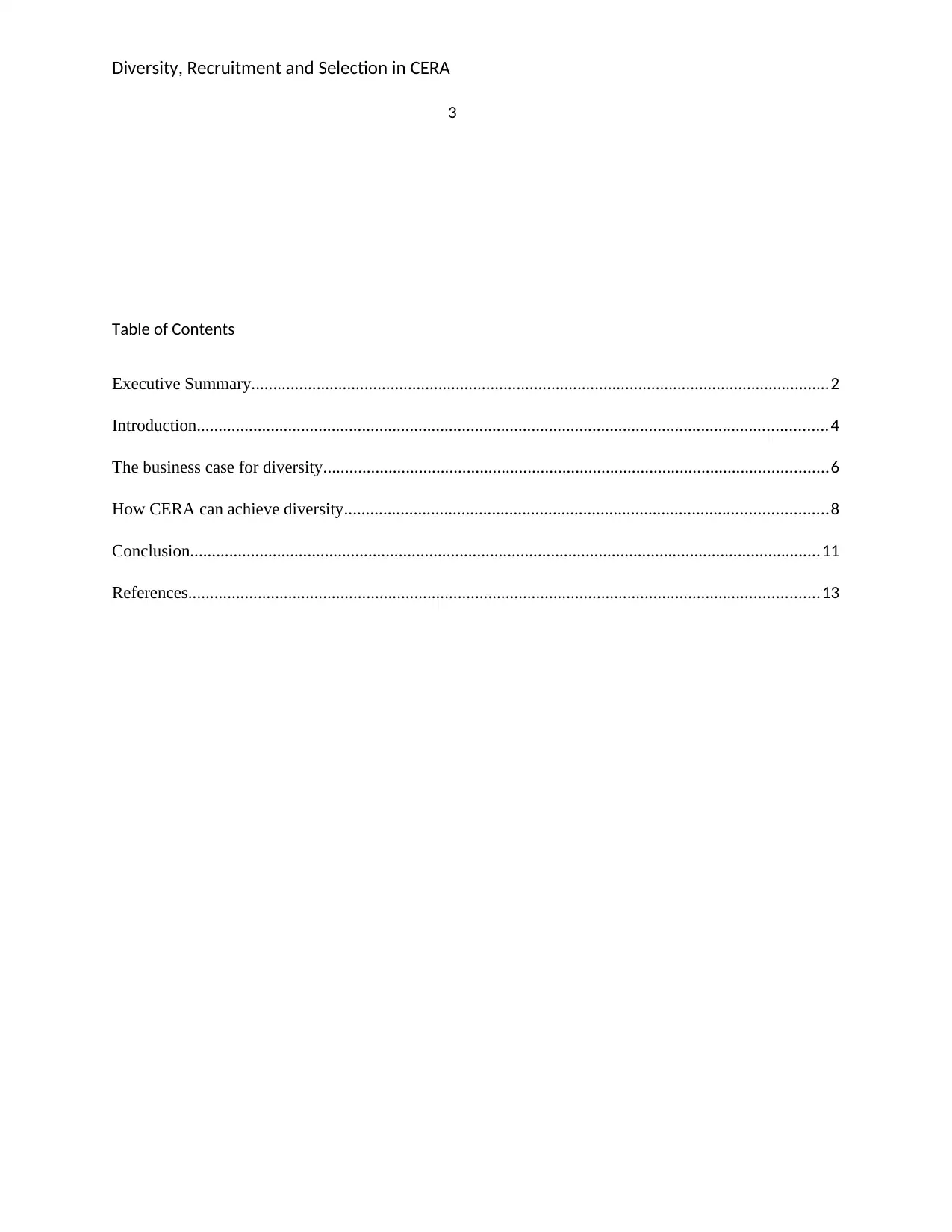
Diversity, Recruitment and Selection in CERA
3
Table of Contents
Executive Summary.....................................................................................................................................2
Introduction.................................................................................................................................................4
The business case for diversity....................................................................................................................6
How CERA can achieve diversity...............................................................................................................8
Conclusion.................................................................................................................................................11
References.................................................................................................................................................13
3
Table of Contents
Executive Summary.....................................................................................................................................2
Introduction.................................................................................................................................................4
The business case for diversity....................................................................................................................6
How CERA can achieve diversity...............................................................................................................8
Conclusion.................................................................................................................................................11
References.................................................................................................................................................13
⊘ This is a preview!⊘
Do you want full access?
Subscribe today to unlock all pages.

Trusted by 1+ million students worldwide
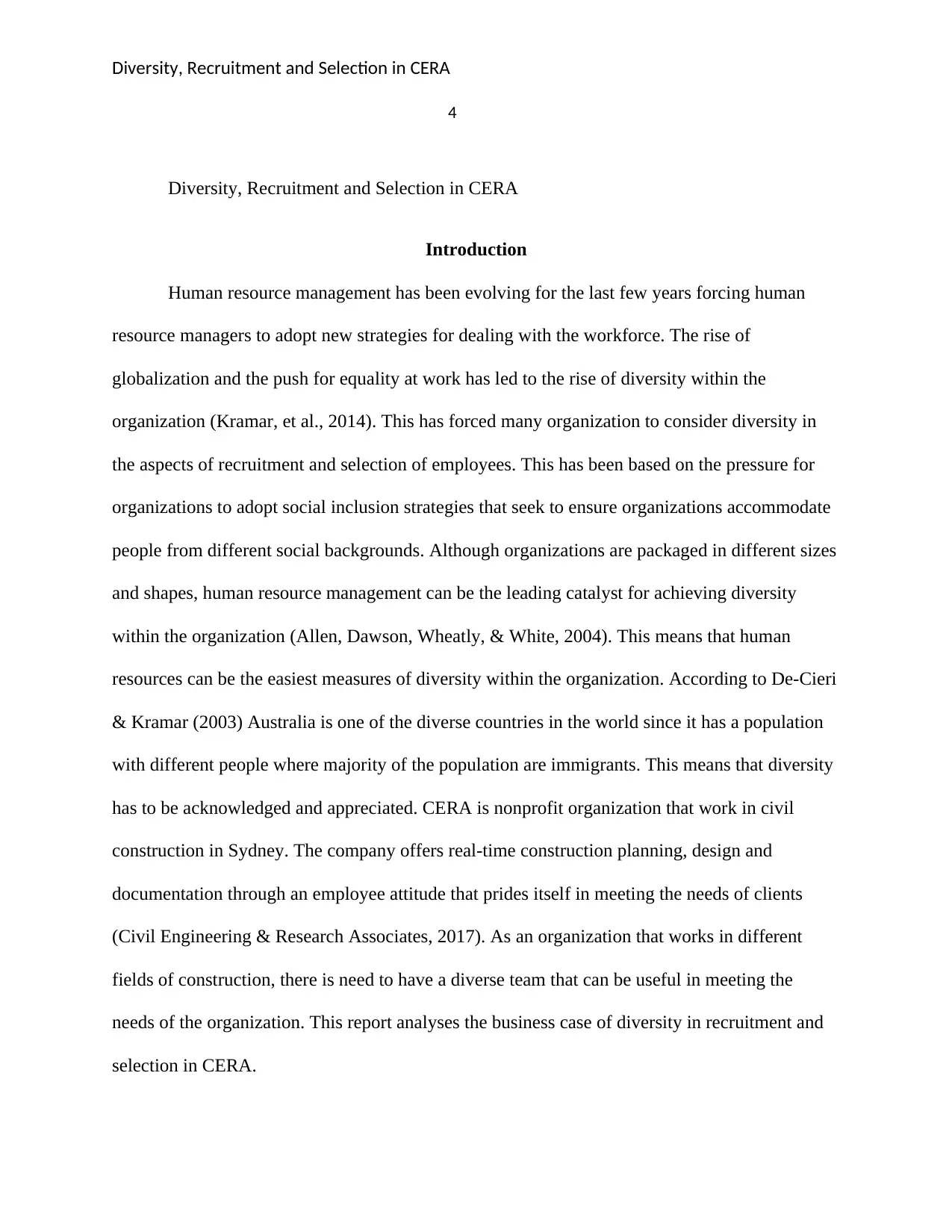
Diversity, Recruitment and Selection in CERA
4
Diversity, Recruitment and Selection in CERA
Introduction
Human resource management has been evolving for the last few years forcing human
resource managers to adopt new strategies for dealing with the workforce. The rise of
globalization and the push for equality at work has led to the rise of diversity within the
organization (Kramar, et al., 2014). This has forced many organization to consider diversity in
the aspects of recruitment and selection of employees. This has been based on the pressure for
organizations to adopt social inclusion strategies that seek to ensure organizations accommodate
people from different social backgrounds. Although organizations are packaged in different sizes
and shapes, human resource management can be the leading catalyst for achieving diversity
within the organization (Allen, Dawson, Wheatly, & White, 2004). This means that human
resources can be the easiest measures of diversity within the organization. According to De-Cieri
& Kramar (2003) Australia is one of the diverse countries in the world since it has a population
with different people where majority of the population are immigrants. This means that diversity
has to be acknowledged and appreciated. CERA is nonprofit organization that work in civil
construction in Sydney. The company offers real-time construction planning, design and
documentation through an employee attitude that prides itself in meeting the needs of clients
(Civil Engineering & Research Associates, 2017). As an organization that works in different
fields of construction, there is need to have a diverse team that can be useful in meeting the
needs of the organization. This report analyses the business case of diversity in recruitment and
selection in CERA.
4
Diversity, Recruitment and Selection in CERA
Introduction
Human resource management has been evolving for the last few years forcing human
resource managers to adopt new strategies for dealing with the workforce. The rise of
globalization and the push for equality at work has led to the rise of diversity within the
organization (Kramar, et al., 2014). This has forced many organization to consider diversity in
the aspects of recruitment and selection of employees. This has been based on the pressure for
organizations to adopt social inclusion strategies that seek to ensure organizations accommodate
people from different social backgrounds. Although organizations are packaged in different sizes
and shapes, human resource management can be the leading catalyst for achieving diversity
within the organization (Allen, Dawson, Wheatly, & White, 2004). This means that human
resources can be the easiest measures of diversity within the organization. According to De-Cieri
& Kramar (2003) Australia is one of the diverse countries in the world since it has a population
with different people where majority of the population are immigrants. This means that diversity
has to be acknowledged and appreciated. CERA is nonprofit organization that work in civil
construction in Sydney. The company offers real-time construction planning, design and
documentation through an employee attitude that prides itself in meeting the needs of clients
(Civil Engineering & Research Associates, 2017). As an organization that works in different
fields of construction, there is need to have a diverse team that can be useful in meeting the
needs of the organization. This report analyses the business case of diversity in recruitment and
selection in CERA.
Paraphrase This Document
Need a fresh take? Get an instant paraphrase of this document with our AI Paraphraser
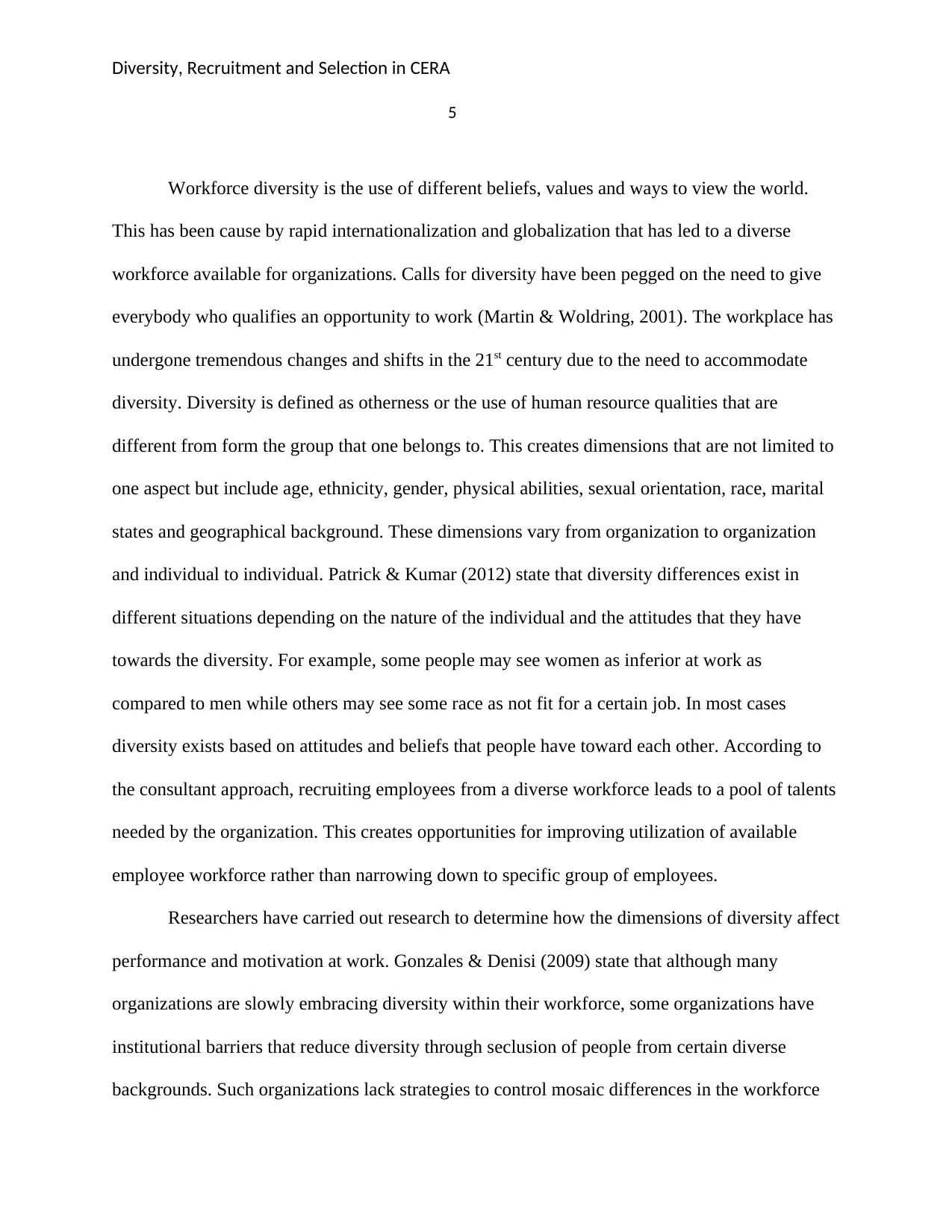
Diversity, Recruitment and Selection in CERA
5
Workforce diversity is the use of different beliefs, values and ways to view the world.
This has been cause by rapid internationalization and globalization that has led to a diverse
workforce available for organizations. Calls for diversity have been pegged on the need to give
everybody who qualifies an opportunity to work (Martin & Woldring, 2001). The workplace has
undergone tremendous changes and shifts in the 21st century due to the need to accommodate
diversity. Diversity is defined as otherness or the use of human resource qualities that are
different from form the group that one belongs to. This creates dimensions that are not limited to
one aspect but include age, ethnicity, gender, physical abilities, sexual orientation, race, marital
states and geographical background. These dimensions vary from organization to organization
and individual to individual. Patrick & Kumar (2012) state that diversity differences exist in
different situations depending on the nature of the individual and the attitudes that they have
towards the diversity. For example, some people may see women as inferior at work as
compared to men while others may see some race as not fit for a certain job. In most cases
diversity exists based on attitudes and beliefs that people have toward each other. According to
the consultant approach, recruiting employees from a diverse workforce leads to a pool of talents
needed by the organization. This creates opportunities for improving utilization of available
employee workforce rather than narrowing down to specific group of employees.
Researchers have carried out research to determine how the dimensions of diversity affect
performance and motivation at work. Gonzales & Denisi (2009) state that although many
organizations are slowly embracing diversity within their workforce, some organizations have
institutional barriers that reduce diversity through seclusion of people from certain diverse
backgrounds. Such organizations lack strategies to control mosaic differences in the workforce
5
Workforce diversity is the use of different beliefs, values and ways to view the world.
This has been cause by rapid internationalization and globalization that has led to a diverse
workforce available for organizations. Calls for diversity have been pegged on the need to give
everybody who qualifies an opportunity to work (Martin & Woldring, 2001). The workplace has
undergone tremendous changes and shifts in the 21st century due to the need to accommodate
diversity. Diversity is defined as otherness or the use of human resource qualities that are
different from form the group that one belongs to. This creates dimensions that are not limited to
one aspect but include age, ethnicity, gender, physical abilities, sexual orientation, race, marital
states and geographical background. These dimensions vary from organization to organization
and individual to individual. Patrick & Kumar (2012) state that diversity differences exist in
different situations depending on the nature of the individual and the attitudes that they have
towards the diversity. For example, some people may see women as inferior at work as
compared to men while others may see some race as not fit for a certain job. In most cases
diversity exists based on attitudes and beliefs that people have toward each other. According to
the consultant approach, recruiting employees from a diverse workforce leads to a pool of talents
needed by the organization. This creates opportunities for improving utilization of available
employee workforce rather than narrowing down to specific group of employees.
Researchers have carried out research to determine how the dimensions of diversity affect
performance and motivation at work. Gonzales & Denisi (2009) state that although many
organizations are slowly embracing diversity within their workforce, some organizations have
institutional barriers that reduce diversity through seclusion of people from certain diverse
backgrounds. Such organizations lack strategies to control mosaic differences in the workforce
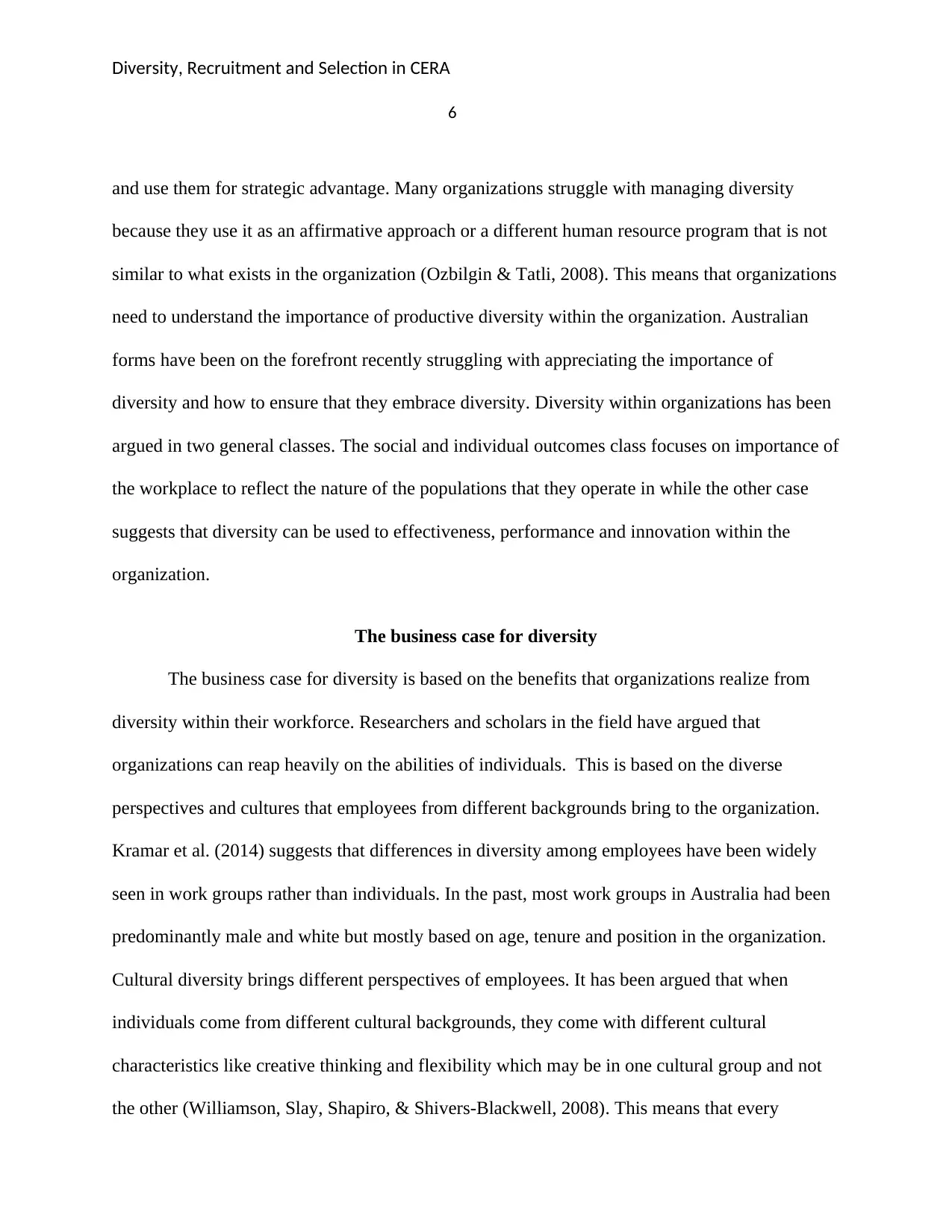
Diversity, Recruitment and Selection in CERA
6
and use them for strategic advantage. Many organizations struggle with managing diversity
because they use it as an affirmative approach or a different human resource program that is not
similar to what exists in the organization (Ozbilgin & Tatli, 2008). This means that organizations
need to understand the importance of productive diversity within the organization. Australian
forms have been on the forefront recently struggling with appreciating the importance of
diversity and how to ensure that they embrace diversity. Diversity within organizations has been
argued in two general classes. The social and individual outcomes class focuses on importance of
the workplace to reflect the nature of the populations that they operate in while the other case
suggests that diversity can be used to effectiveness, performance and innovation within the
organization.
The business case for diversity
The business case for diversity is based on the benefits that organizations realize from
diversity within their workforce. Researchers and scholars in the field have argued that
organizations can reap heavily on the abilities of individuals. This is based on the diverse
perspectives and cultures that employees from different backgrounds bring to the organization.
Kramar et al. (2014) suggests that differences in diversity among employees have been widely
seen in work groups rather than individuals. In the past, most work groups in Australia had been
predominantly male and white but mostly based on age, tenure and position in the organization.
Cultural diversity brings different perspectives of employees. It has been argued that when
individuals come from different cultural backgrounds, they come with different cultural
characteristics like creative thinking and flexibility which may be in one cultural group and not
the other (Williamson, Slay, Shapiro, & Shivers-Blackwell, 2008). This means that every
6
and use them for strategic advantage. Many organizations struggle with managing diversity
because they use it as an affirmative approach or a different human resource program that is not
similar to what exists in the organization (Ozbilgin & Tatli, 2008). This means that organizations
need to understand the importance of productive diversity within the organization. Australian
forms have been on the forefront recently struggling with appreciating the importance of
diversity and how to ensure that they embrace diversity. Diversity within organizations has been
argued in two general classes. The social and individual outcomes class focuses on importance of
the workplace to reflect the nature of the populations that they operate in while the other case
suggests that diversity can be used to effectiveness, performance and innovation within the
organization.
The business case for diversity
The business case for diversity is based on the benefits that organizations realize from
diversity within their workforce. Researchers and scholars in the field have argued that
organizations can reap heavily on the abilities of individuals. This is based on the diverse
perspectives and cultures that employees from different backgrounds bring to the organization.
Kramar et al. (2014) suggests that differences in diversity among employees have been widely
seen in work groups rather than individuals. In the past, most work groups in Australia had been
predominantly male and white but mostly based on age, tenure and position in the organization.
Cultural diversity brings different perspectives of employees. It has been argued that when
individuals come from different cultural backgrounds, they come with different cultural
characteristics like creative thinking and flexibility which may be in one cultural group and not
the other (Williamson, Slay, Shapiro, & Shivers-Blackwell, 2008). This means that every
⊘ This is a preview!⊘
Do you want full access?
Subscribe today to unlock all pages.

Trusted by 1+ million students worldwide
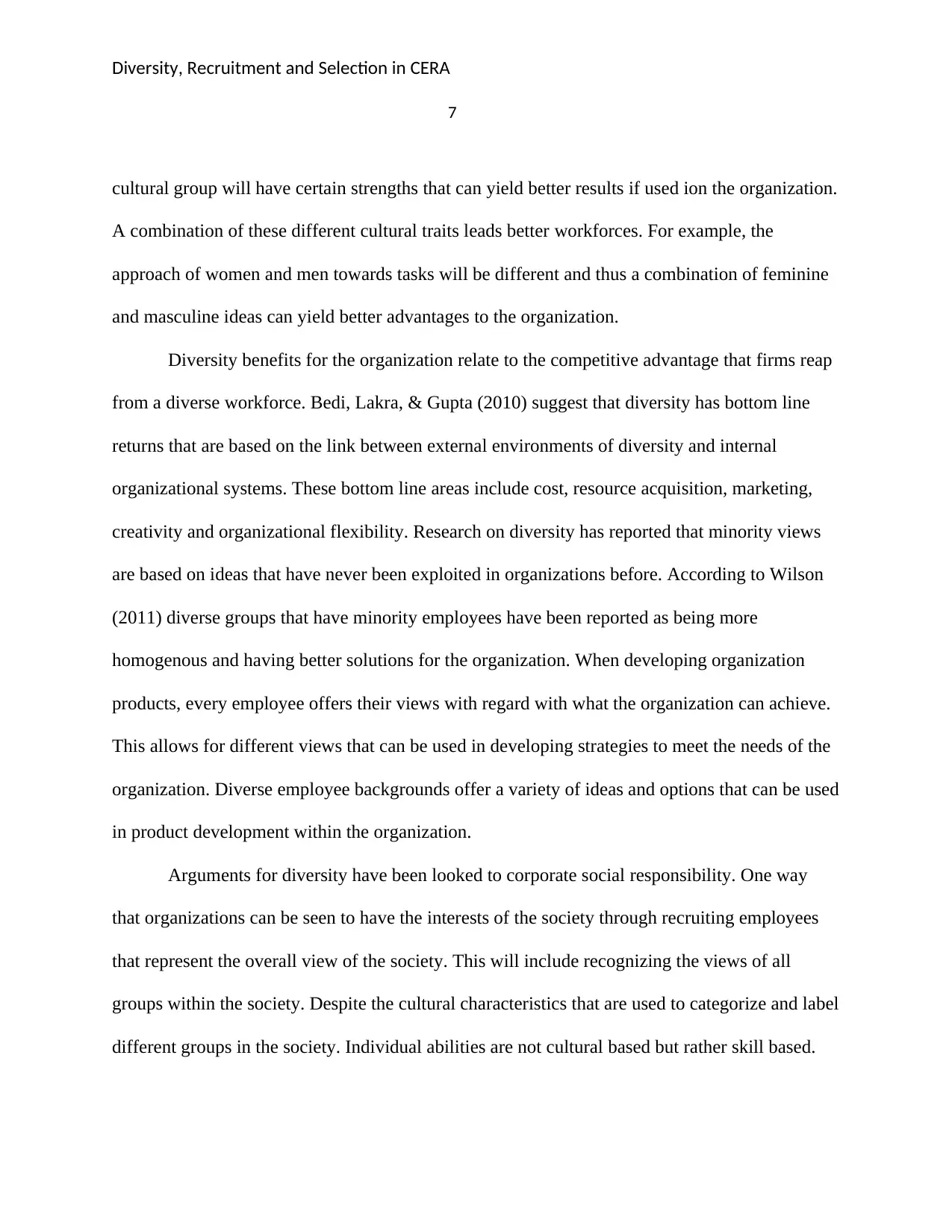
Diversity, Recruitment and Selection in CERA
7
cultural group will have certain strengths that can yield better results if used ion the organization.
A combination of these different cultural traits leads better workforces. For example, the
approach of women and men towards tasks will be different and thus a combination of feminine
and masculine ideas can yield better advantages to the organization.
Diversity benefits for the organization relate to the competitive advantage that firms reap
from a diverse workforce. Bedi, Lakra, & Gupta (2010) suggest that diversity has bottom line
returns that are based on the link between external environments of diversity and internal
organizational systems. These bottom line areas include cost, resource acquisition, marketing,
creativity and organizational flexibility. Research on diversity has reported that minority views
are based on ideas that have never been exploited in organizations before. According to Wilson
(2011) diverse groups that have minority employees have been reported as being more
homogenous and having better solutions for the organization. When developing organization
products, every employee offers their views with regard with what the organization can achieve.
This allows for different views that can be used in developing strategies to meet the needs of the
organization. Diverse employee backgrounds offer a variety of ideas and options that can be used
in product development within the organization.
Arguments for diversity have been looked to corporate social responsibility. One way
that organizations can be seen to have the interests of the society through recruiting employees
that represent the overall view of the society. This will include recognizing the views of all
groups within the society. Despite the cultural characteristics that are used to categorize and label
different groups in the society. Individual abilities are not cultural based but rather skill based.
7
cultural group will have certain strengths that can yield better results if used ion the organization.
A combination of these different cultural traits leads better workforces. For example, the
approach of women and men towards tasks will be different and thus a combination of feminine
and masculine ideas can yield better advantages to the organization.
Diversity benefits for the organization relate to the competitive advantage that firms reap
from a diverse workforce. Bedi, Lakra, & Gupta (2010) suggest that diversity has bottom line
returns that are based on the link between external environments of diversity and internal
organizational systems. These bottom line areas include cost, resource acquisition, marketing,
creativity and organizational flexibility. Research on diversity has reported that minority views
are based on ideas that have never been exploited in organizations before. According to Wilson
(2011) diverse groups that have minority employees have been reported as being more
homogenous and having better solutions for the organization. When developing organization
products, every employee offers their views with regard with what the organization can achieve.
This allows for different views that can be used in developing strategies to meet the needs of the
organization. Diverse employee backgrounds offer a variety of ideas and options that can be used
in product development within the organization.
Arguments for diversity have been looked to corporate social responsibility. One way
that organizations can be seen to have the interests of the society through recruiting employees
that represent the overall view of the society. This will include recognizing the views of all
groups within the society. Despite the cultural characteristics that are used to categorize and label
different groups in the society. Individual abilities are not cultural based but rather skill based.
Paraphrase This Document
Need a fresh take? Get an instant paraphrase of this document with our AI Paraphraser
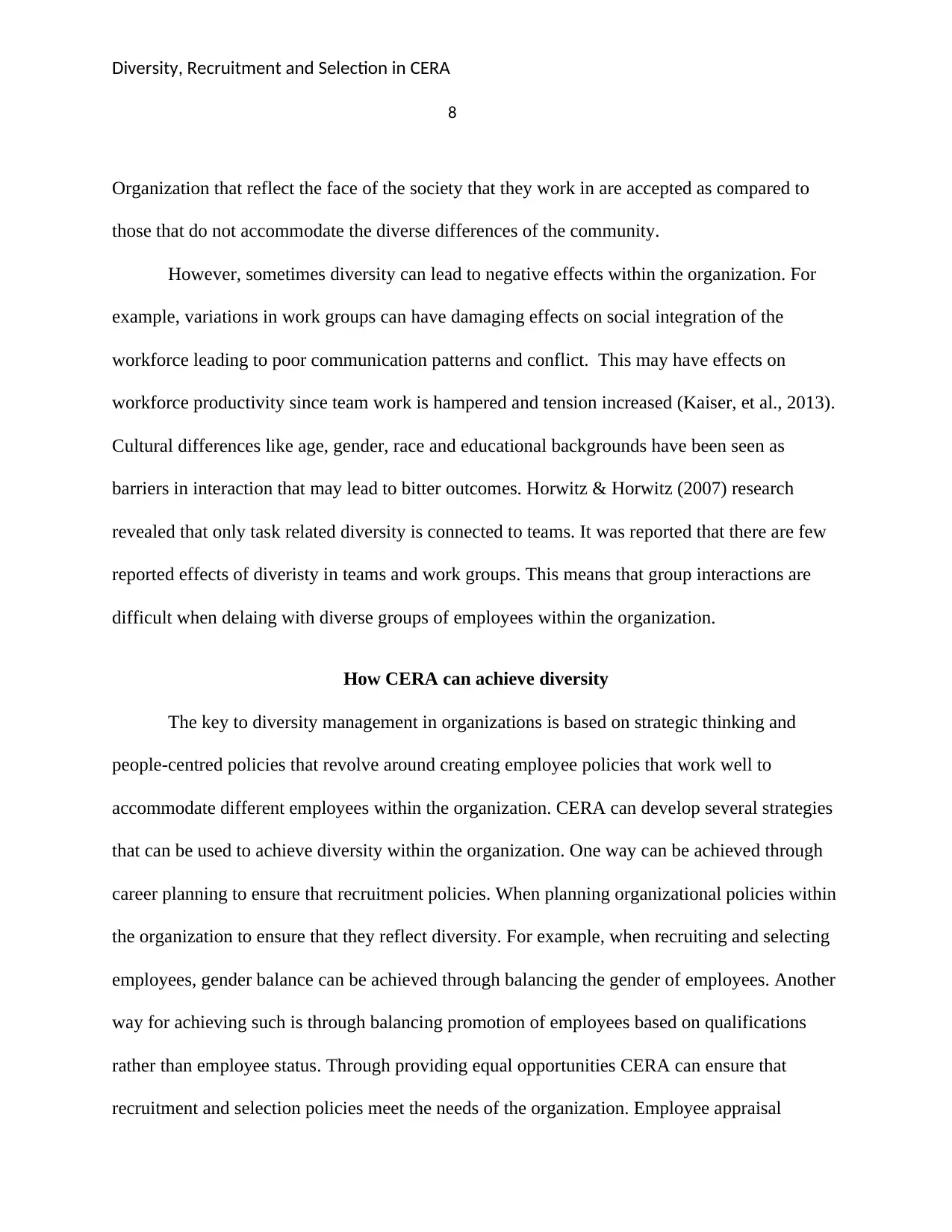
Diversity, Recruitment and Selection in CERA
8
Organization that reflect the face of the society that they work in are accepted as compared to
those that do not accommodate the diverse differences of the community.
However, sometimes diversity can lead to negative effects within the organization. For
example, variations in work groups can have damaging effects on social integration of the
workforce leading to poor communication patterns and conflict. This may have effects on
workforce productivity since team work is hampered and tension increased (Kaiser, et al., 2013).
Cultural differences like age, gender, race and educational backgrounds have been seen as
barriers in interaction that may lead to bitter outcomes. Horwitz & Horwitz (2007) research
revealed that only task related diversity is connected to teams. It was reported that there are few
reported effects of diveristy in teams and work groups. This means that group interactions are
difficult when delaing with diverse groups of employees within the organization.
How CERA can achieve diversity
The key to diversity management in organizations is based on strategic thinking and
people-centred policies that revolve around creating employee policies that work well to
accommodate different employees within the organization. CERA can develop several strategies
that can be used to achieve diversity within the organization. One way can be achieved through
career planning to ensure that recruitment policies. When planning organizational policies within
the organization to ensure that they reflect diversity. For example, when recruiting and selecting
employees, gender balance can be achieved through balancing the gender of employees. Another
way for achieving such is through balancing promotion of employees based on qualifications
rather than employee status. Through providing equal opportunities CERA can ensure that
recruitment and selection policies meet the needs of the organization. Employee appraisal
8
Organization that reflect the face of the society that they work in are accepted as compared to
those that do not accommodate the diverse differences of the community.
However, sometimes diversity can lead to negative effects within the organization. For
example, variations in work groups can have damaging effects on social integration of the
workforce leading to poor communication patterns and conflict. This may have effects on
workforce productivity since team work is hampered and tension increased (Kaiser, et al., 2013).
Cultural differences like age, gender, race and educational backgrounds have been seen as
barriers in interaction that may lead to bitter outcomes. Horwitz & Horwitz (2007) research
revealed that only task related diversity is connected to teams. It was reported that there are few
reported effects of diveristy in teams and work groups. This means that group interactions are
difficult when delaing with diverse groups of employees within the organization.
How CERA can achieve diversity
The key to diversity management in organizations is based on strategic thinking and
people-centred policies that revolve around creating employee policies that work well to
accommodate different employees within the organization. CERA can develop several strategies
that can be used to achieve diversity within the organization. One way can be achieved through
career planning to ensure that recruitment policies. When planning organizational policies within
the organization to ensure that they reflect diversity. For example, when recruiting and selecting
employees, gender balance can be achieved through balancing the gender of employees. Another
way for achieving such is through balancing promotion of employees based on qualifications
rather than employee status. Through providing equal opportunities CERA can ensure that
recruitment and selection policies meet the needs of the organization. Employee appraisal
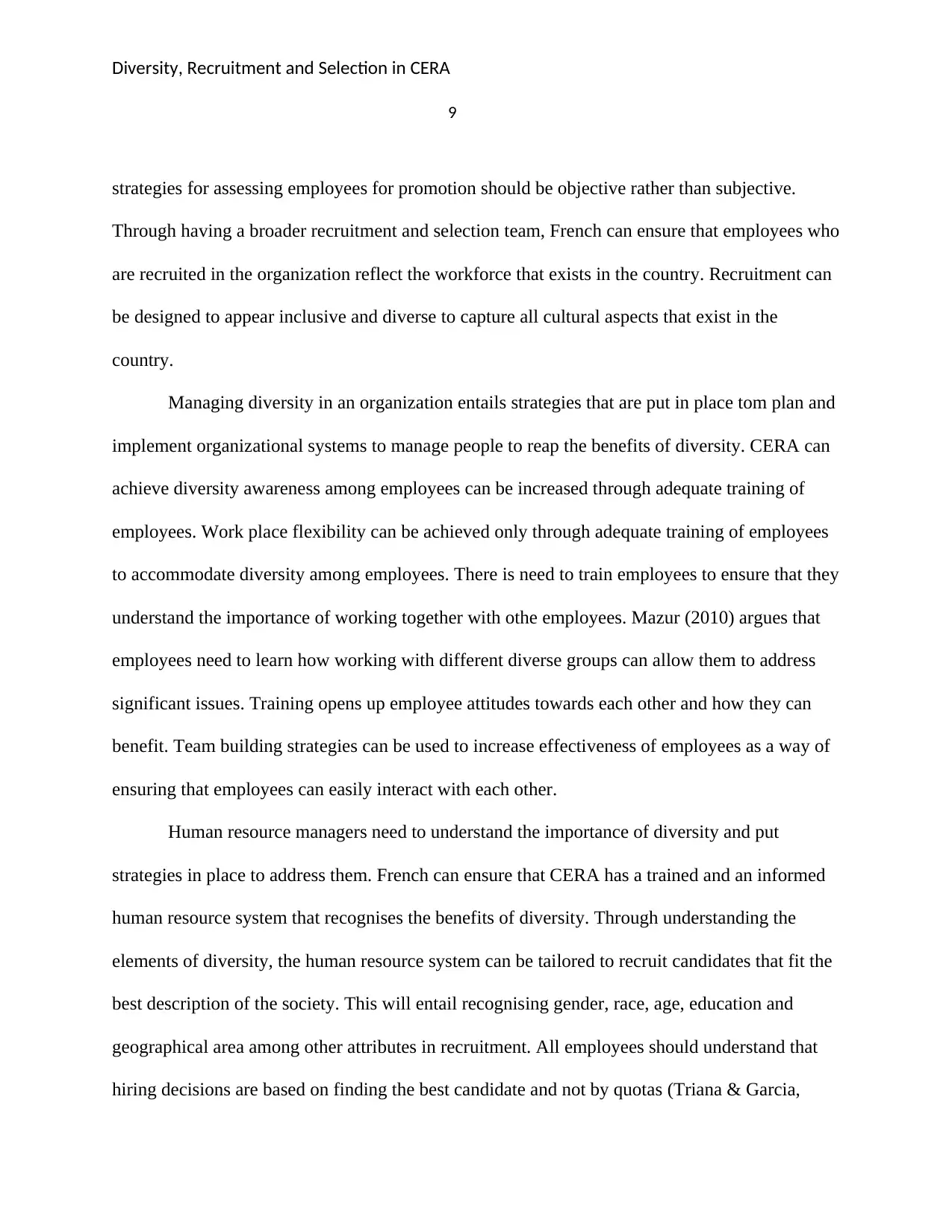
Diversity, Recruitment and Selection in CERA
9
strategies for assessing employees for promotion should be objective rather than subjective.
Through having a broader recruitment and selection team, French can ensure that employees who
are recruited in the organization reflect the workforce that exists in the country. Recruitment can
be designed to appear inclusive and diverse to capture all cultural aspects that exist in the
country.
Managing diversity in an organization entails strategies that are put in place tom plan and
implement organizational systems to manage people to reap the benefits of diversity. CERA can
achieve diversity awareness among employees can be increased through adequate training of
employees. Work place flexibility can be achieved only through adequate training of employees
to accommodate diversity among employees. There is need to train employees to ensure that they
understand the importance of working together with othe employees. Mazur (2010) argues that
employees need to learn how working with different diverse groups can allow them to address
significant issues. Training opens up employee attitudes towards each other and how they can
benefit. Team building strategies can be used to increase effectiveness of employees as a way of
ensuring that employees can easily interact with each other.
Human resource managers need to understand the importance of diversity and put
strategies in place to address them. French can ensure that CERA has a trained and an informed
human resource system that recognises the benefits of diversity. Through understanding the
elements of diversity, the human resource system can be tailored to recruit candidates that fit the
best description of the society. This will entail recognising gender, race, age, education and
geographical area among other attributes in recruitment. All employees should understand that
hiring decisions are based on finding the best candidate and not by quotas (Triana & Garcia,
9
strategies for assessing employees for promotion should be objective rather than subjective.
Through having a broader recruitment and selection team, French can ensure that employees who
are recruited in the organization reflect the workforce that exists in the country. Recruitment can
be designed to appear inclusive and diverse to capture all cultural aspects that exist in the
country.
Managing diversity in an organization entails strategies that are put in place tom plan and
implement organizational systems to manage people to reap the benefits of diversity. CERA can
achieve diversity awareness among employees can be increased through adequate training of
employees. Work place flexibility can be achieved only through adequate training of employees
to accommodate diversity among employees. There is need to train employees to ensure that they
understand the importance of working together with othe employees. Mazur (2010) argues that
employees need to learn how working with different diverse groups can allow them to address
significant issues. Training opens up employee attitudes towards each other and how they can
benefit. Team building strategies can be used to increase effectiveness of employees as a way of
ensuring that employees can easily interact with each other.
Human resource managers need to understand the importance of diversity and put
strategies in place to address them. French can ensure that CERA has a trained and an informed
human resource system that recognises the benefits of diversity. Through understanding the
elements of diversity, the human resource system can be tailored to recruit candidates that fit the
best description of the society. This will entail recognising gender, race, age, education and
geographical area among other attributes in recruitment. All employees should understand that
hiring decisions are based on finding the best candidate and not by quotas (Triana & Garcia,
⊘ This is a preview!⊘
Do you want full access?
Subscribe today to unlock all pages.

Trusted by 1+ million students worldwide
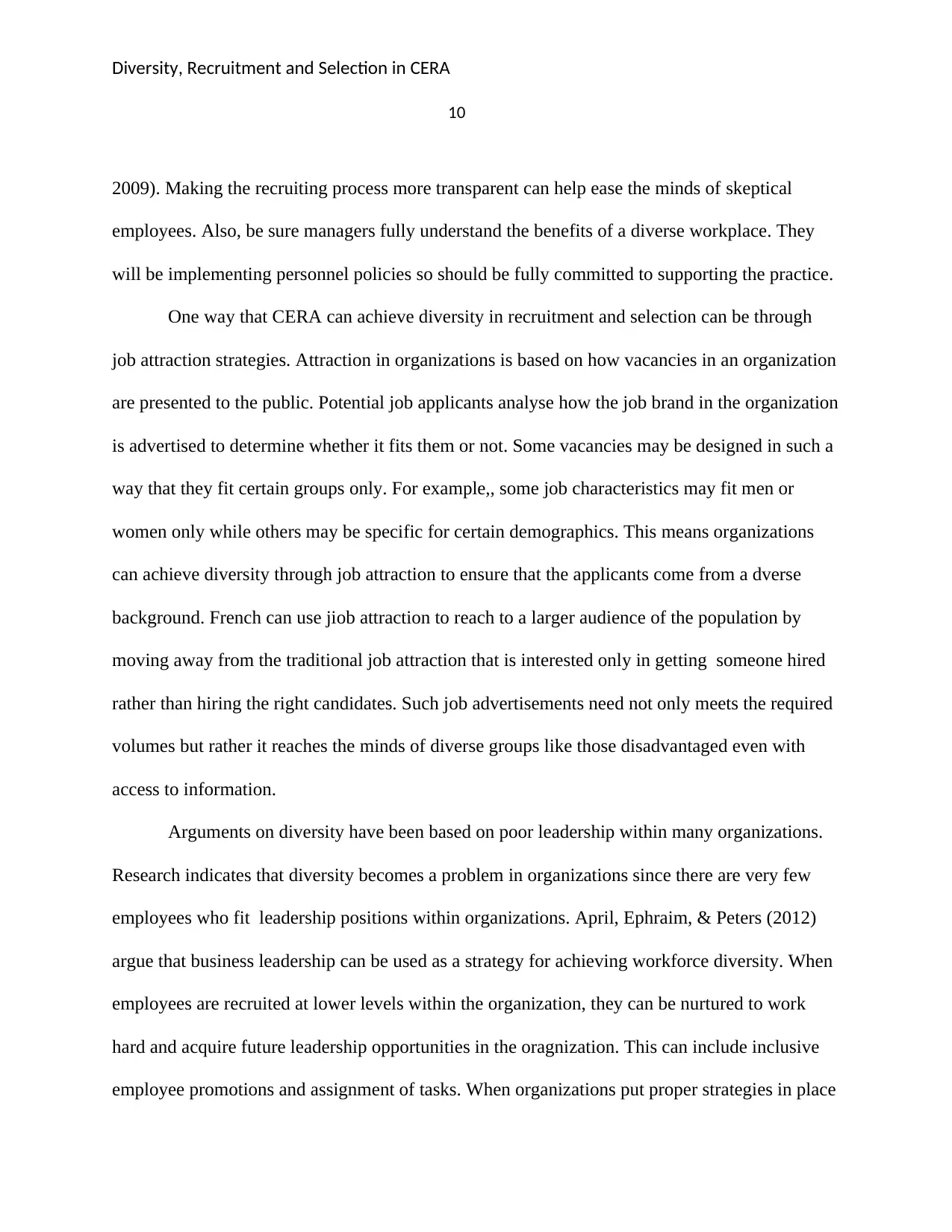
Diversity, Recruitment and Selection in CERA
10
2009). Making the recruiting process more transparent can help ease the minds of skeptical
employees. Also, be sure managers fully understand the benefits of a diverse workplace. They
will be implementing personnel policies so should be fully committed to supporting the practice.
One way that CERA can achieve diversity in recruitment and selection can be through
job attraction strategies. Attraction in organizations is based on how vacancies in an organization
are presented to the public. Potential job applicants analyse how the job brand in the organization
is advertised to determine whether it fits them or not. Some vacancies may be designed in such a
way that they fit certain groups only. For example,, some job characteristics may fit men or
women only while others may be specific for certain demographics. This means organizations
can achieve diversity through job attraction to ensure that the applicants come from a dverse
background. French can use jiob attraction to reach to a larger audience of the population by
moving away from the traditional job attraction that is interested only in getting someone hired
rather than hiring the right candidates. Such job advertisements need not only meets the required
volumes but rather it reaches the minds of diverse groups like those disadvantaged even with
access to information.
Arguments on diversity have been based on poor leadership within many organizations.
Research indicates that diversity becomes a problem in organizations since there are very few
employees who fit leadership positions within organizations. April, Ephraim, & Peters (2012)
argue that business leadership can be used as a strategy for achieving workforce diversity. When
employees are recruited at lower levels within the organization, they can be nurtured to work
hard and acquire future leadership opportunities in the oragnization. This can include inclusive
employee promotions and assignment of tasks. When organizations put proper strategies in place
10
2009). Making the recruiting process more transparent can help ease the minds of skeptical
employees. Also, be sure managers fully understand the benefits of a diverse workplace. They
will be implementing personnel policies so should be fully committed to supporting the practice.
One way that CERA can achieve diversity in recruitment and selection can be through
job attraction strategies. Attraction in organizations is based on how vacancies in an organization
are presented to the public. Potential job applicants analyse how the job brand in the organization
is advertised to determine whether it fits them or not. Some vacancies may be designed in such a
way that they fit certain groups only. For example,, some job characteristics may fit men or
women only while others may be specific for certain demographics. This means organizations
can achieve diversity through job attraction to ensure that the applicants come from a dverse
background. French can use jiob attraction to reach to a larger audience of the population by
moving away from the traditional job attraction that is interested only in getting someone hired
rather than hiring the right candidates. Such job advertisements need not only meets the required
volumes but rather it reaches the minds of diverse groups like those disadvantaged even with
access to information.
Arguments on diversity have been based on poor leadership within many organizations.
Research indicates that diversity becomes a problem in organizations since there are very few
employees who fit leadership positions within organizations. April, Ephraim, & Peters (2012)
argue that business leadership can be used as a strategy for achieving workforce diversity. When
employees are recruited at lower levels within the organization, they can be nurtured to work
hard and acquire future leadership opportunities in the oragnization. This can include inclusive
employee promotions and assignment of tasks. When organizations put proper strategies in place
Paraphrase This Document
Need a fresh take? Get an instant paraphrase of this document with our AI Paraphraser
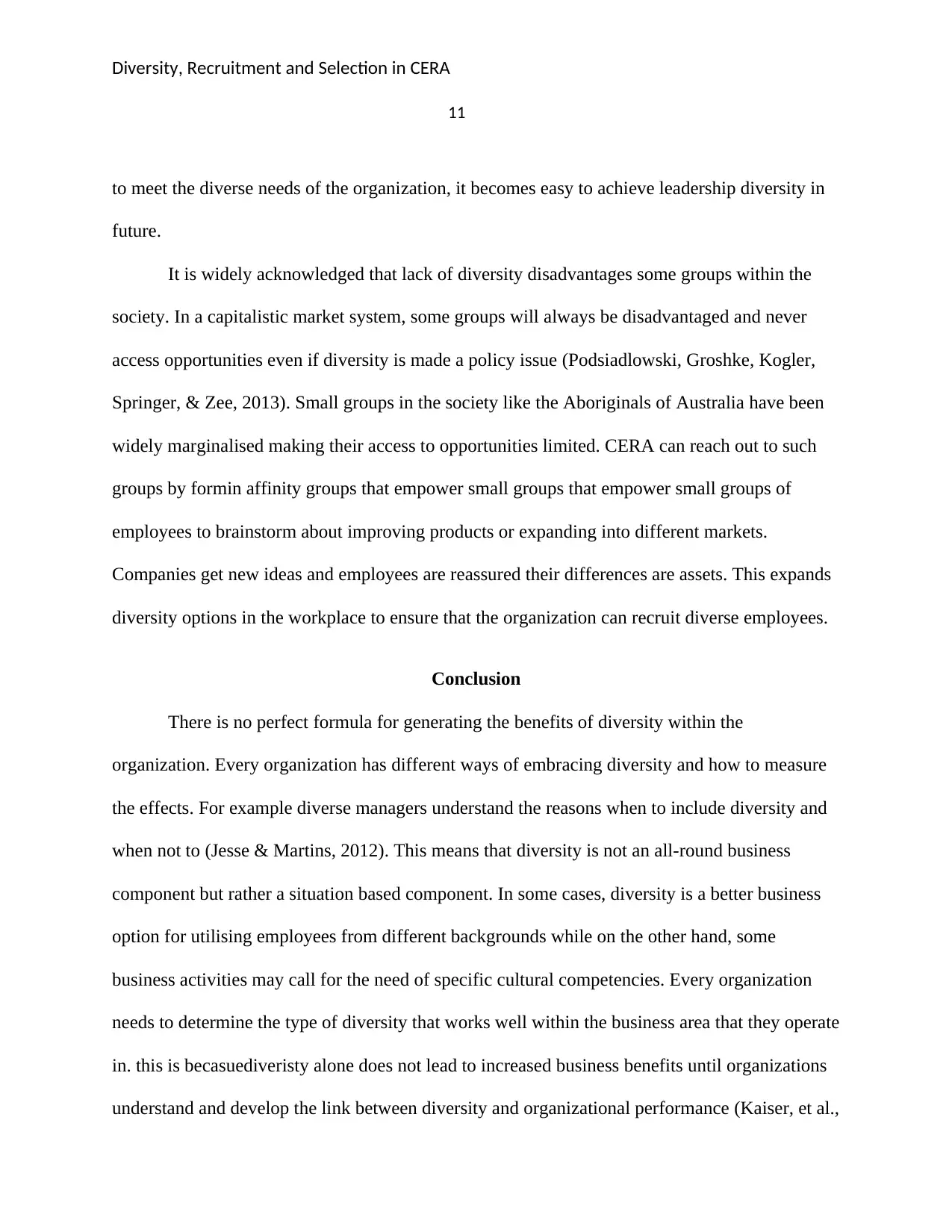
Diversity, Recruitment and Selection in CERA
11
to meet the diverse needs of the organization, it becomes easy to achieve leadership diversity in
future.
It is widely acknowledged that lack of diversity disadvantages some groups within the
society. In a capitalistic market system, some groups will always be disadvantaged and never
access opportunities even if diversity is made a policy issue (Podsiadlowski, Groshke, Kogler,
Springer, & Zee, 2013). Small groups in the society like the Aboriginals of Australia have been
widely marginalised making their access to opportunities limited. CERA can reach out to such
groups by formin affinity groups that empower small groups that empower small groups of
employees to brainstorm about improving products or expanding into different markets.
Companies get new ideas and employees are reassured their differences are assets. This expands
diversity options in the workplace to ensure that the organization can recruit diverse employees.
Conclusion
There is no perfect formula for generating the benefits of diversity within the
organization. Every organization has different ways of embracing diversity and how to measure
the effects. For example diverse managers understand the reasons when to include diversity and
when not to (Jesse & Martins, 2012). This means that diversity is not an all-round business
component but rather a situation based component. In some cases, diversity is a better business
option for utilising employees from different backgrounds while on the other hand, some
business activities may call for the need of specific cultural competencies. Every organization
needs to determine the type of diversity that works well within the business area that they operate
in. this is becasuediveristy alone does not lead to increased business benefits until organizations
understand and develop the link between diversity and organizational performance (Kaiser, et al.,
11
to meet the diverse needs of the organization, it becomes easy to achieve leadership diversity in
future.
It is widely acknowledged that lack of diversity disadvantages some groups within the
society. In a capitalistic market system, some groups will always be disadvantaged and never
access opportunities even if diversity is made a policy issue (Podsiadlowski, Groshke, Kogler,
Springer, & Zee, 2013). Small groups in the society like the Aboriginals of Australia have been
widely marginalised making their access to opportunities limited. CERA can reach out to such
groups by formin affinity groups that empower small groups that empower small groups of
employees to brainstorm about improving products or expanding into different markets.
Companies get new ideas and employees are reassured their differences are assets. This expands
diversity options in the workplace to ensure that the organization can recruit diverse employees.
Conclusion
There is no perfect formula for generating the benefits of diversity within the
organization. Every organization has different ways of embracing diversity and how to measure
the effects. For example diverse managers understand the reasons when to include diversity and
when not to (Jesse & Martins, 2012). This means that diversity is not an all-round business
component but rather a situation based component. In some cases, diversity is a better business
option for utilising employees from different backgrounds while on the other hand, some
business activities may call for the need of specific cultural competencies. Every organization
needs to determine the type of diversity that works well within the business area that they operate
in. this is becasuediveristy alone does not lead to increased business benefits until organizations
understand and develop the link between diversity and organizational performance (Kaiser, et al.,
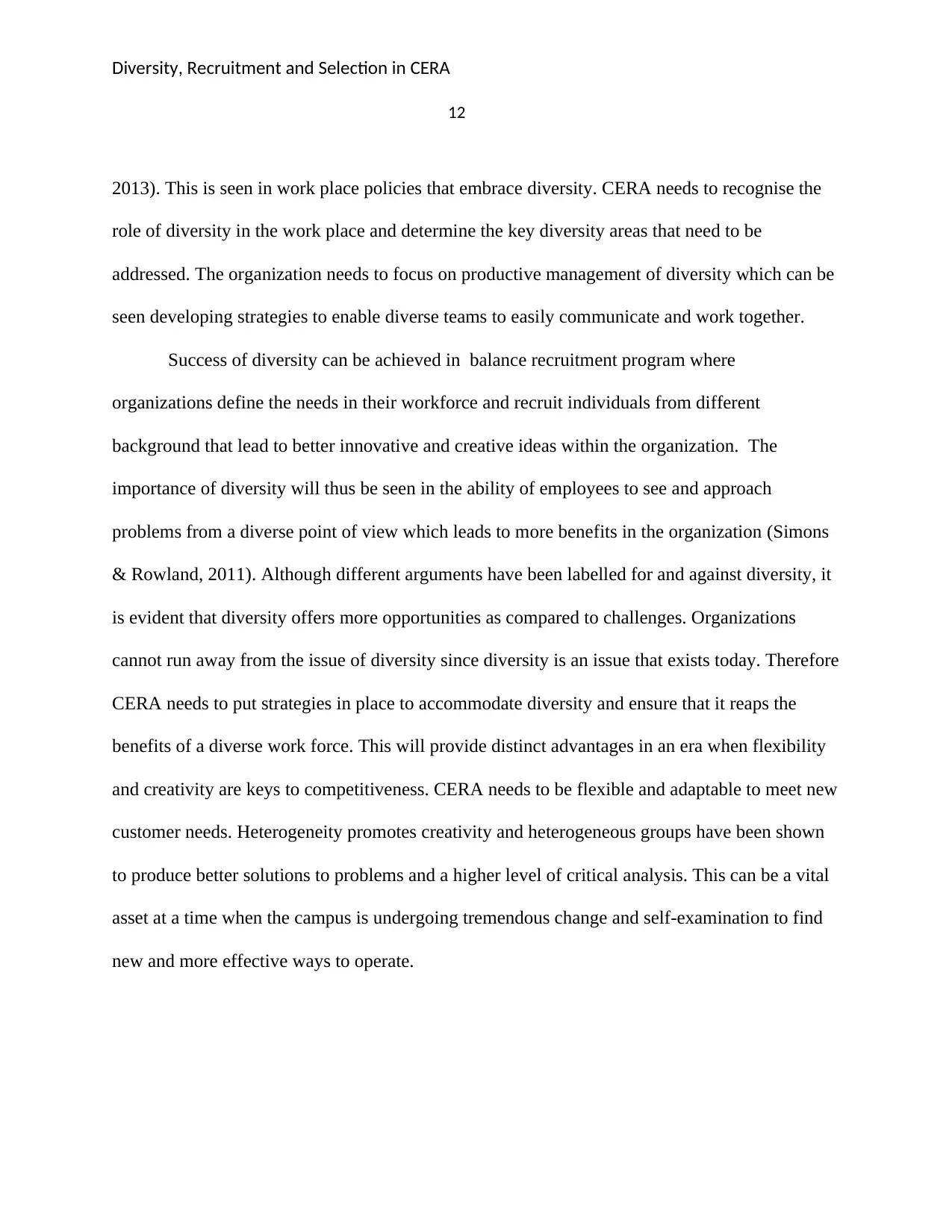
Diversity, Recruitment and Selection in CERA
12
2013). This is seen in work place policies that embrace diversity. CERA needs to recognise the
role of diversity in the work place and determine the key diversity areas that need to be
addressed. The organization needs to focus on productive management of diversity which can be
seen developing strategies to enable diverse teams to easily communicate and work together.
Success of diversity can be achieved in balance recruitment program where
organizations define the needs in their workforce and recruit individuals from different
background that lead to better innovative and creative ideas within the organization. The
importance of diversity will thus be seen in the ability of employees to see and approach
problems from a diverse point of view which leads to more benefits in the organization (Simons
& Rowland, 2011). Although different arguments have been labelled for and against diversity, it
is evident that diversity offers more opportunities as compared to challenges. Organizations
cannot run away from the issue of diversity since diversity is an issue that exists today. Therefore
CERA needs to put strategies in place to accommodate diversity and ensure that it reaps the
benefits of a diverse work force. This will provide distinct advantages in an era when flexibility
and creativity are keys to competitiveness. CERA needs to be flexible and adaptable to meet new
customer needs. Heterogeneity promotes creativity and heterogeneous groups have been shown
to produce better solutions to problems and a higher level of critical analysis. This can be a vital
asset at a time when the campus is undergoing tremendous change and self-examination to find
new and more effective ways to operate.
12
2013). This is seen in work place policies that embrace diversity. CERA needs to recognise the
role of diversity in the work place and determine the key diversity areas that need to be
addressed. The organization needs to focus on productive management of diversity which can be
seen developing strategies to enable diverse teams to easily communicate and work together.
Success of diversity can be achieved in balance recruitment program where
organizations define the needs in their workforce and recruit individuals from different
background that lead to better innovative and creative ideas within the organization. The
importance of diversity will thus be seen in the ability of employees to see and approach
problems from a diverse point of view which leads to more benefits in the organization (Simons
& Rowland, 2011). Although different arguments have been labelled for and against diversity, it
is evident that diversity offers more opportunities as compared to challenges. Organizations
cannot run away from the issue of diversity since diversity is an issue that exists today. Therefore
CERA needs to put strategies in place to accommodate diversity and ensure that it reaps the
benefits of a diverse work force. This will provide distinct advantages in an era when flexibility
and creativity are keys to competitiveness. CERA needs to be flexible and adaptable to meet new
customer needs. Heterogeneity promotes creativity and heterogeneous groups have been shown
to produce better solutions to problems and a higher level of critical analysis. This can be a vital
asset at a time when the campus is undergoing tremendous change and self-examination to find
new and more effective ways to operate.
⊘ This is a preview!⊘
Do you want full access?
Subscribe today to unlock all pages.

Trusted by 1+ million students worldwide
1 out of 15
Related Documents
Your All-in-One AI-Powered Toolkit for Academic Success.
+13062052269
info@desklib.com
Available 24*7 on WhatsApp / Email
![[object Object]](/_next/static/media/star-bottom.7253800d.svg)
Unlock your academic potential
Copyright © 2020–2025 A2Z Services. All Rights Reserved. Developed and managed by ZUCOL.





